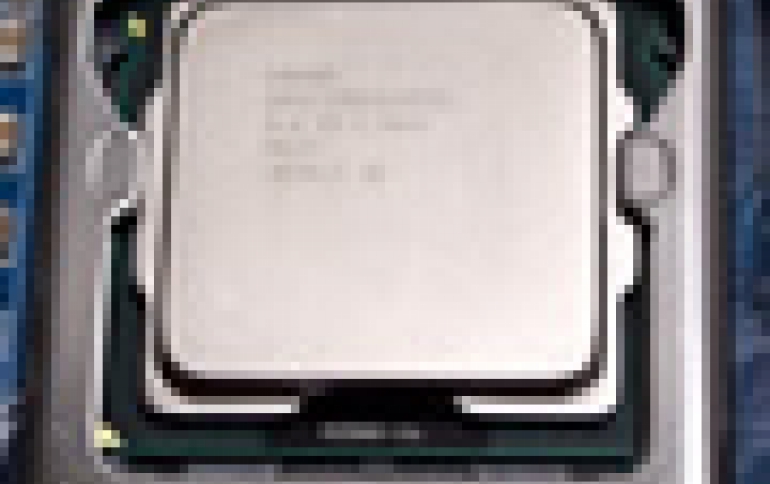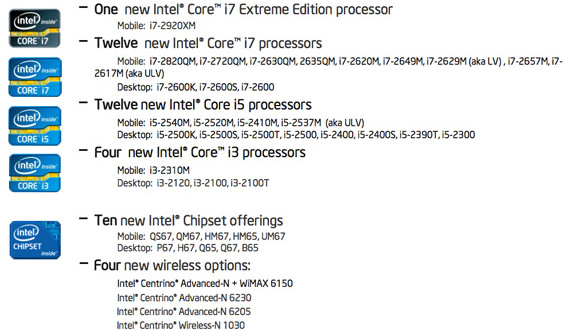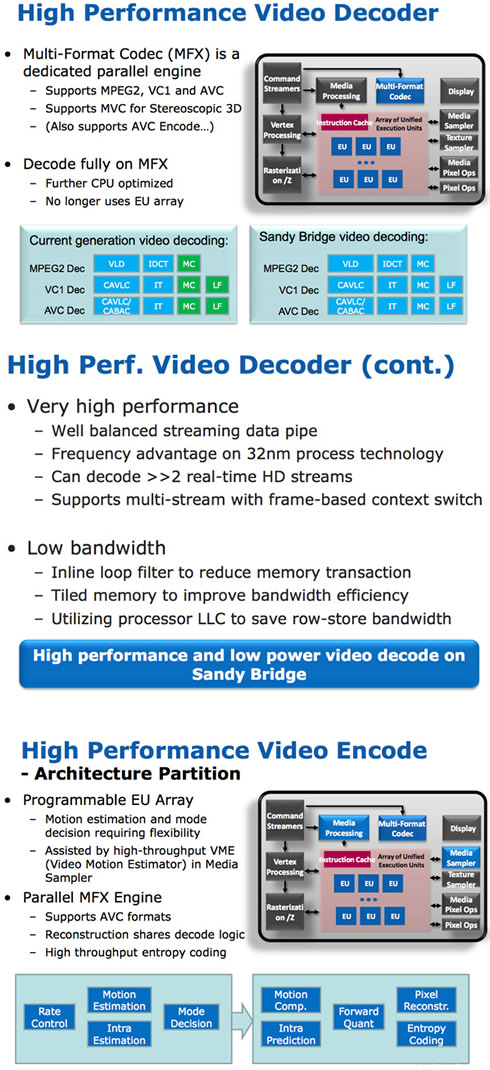
2nd Generation Intel Core Processor Family to Debut at CES 2011
Intel will officially unveil its 2nd Generation Intel Core processor family (Sandy Bridge) for desktop and mobile computers on Jan. 5 at the 2011 CES 2011 show in Las Vegas.
Sandy Bridge chips pack a graphics chip directly onto the main
processor, boosting performance. This design essentially provides the
graphics function for free, allowing PC makers to bring out laptops
that don't have to always rely on separate graphics processors from
Advanced Micro Devices or Nvidia.
Sandy Bridge highlights:
* 20 new Core i3, i5, i7 processors: First chips available
(January) in laptops will be quad-core.
* More than 500 new PC systems: coming from PC makers
worldwide.
* Enhanced graphics silicon: built directly onto the main
processor.
* Quick Sync Video: accelerates encoding/decoding of media
formats.
* Turbo Boost 2.0: power-efficient overclocking of processor.
* Intel Wireless Display 2.0: WiDi 2.0 beams content to
big-screen HDTVs at 1080pHD resolution.
* Intel Insider: direct access to movies on PCs in high
definition.

The new chips offer a boost in energy-efficient performance, according to Intel, with on-chip graphics, and new Advanced Vector Extension (AVX) instructions to accelerate multimedia handling, offering a 2x gain in performance over current chips.
At the top-end of the range is the mobile i7-2920XM, a quad-core Extreme Edition processor with a base frequency of 2.5GHz, but which can rise to 3.5GHz when necessary using Intel's updated Turbo Boost technology.
The rest of the line-up consists of 12 new standard Core i7 chips, 12 Core i5, and four Core i3 models, covering both desktop and laptop systems in dual-core and quad-core versions.
Sandy Bridge is a completely new processor architecture manufactured on Intel's 32nm fabrication technology. The new architecture has been designed to deliver significant advances in visual and 3D graphics capabilities, Intel said, with re-designed on-chip graphics circuitry that shares the same L3 cache as the processor cores.
New features include Advanced Vector Extension (AVX) instructions, which process floating-point calculations in 256-bit chunks to accelerate image, video and audio processing.
However, AVX is not supported in current versions of Windows, and users will require the yet to be released Windows 7 Service Pack 1 to make use of this feature.
One of Sandy Bridge's important features is high-speed, on-the-fly conversion between data formats. The chip also includes the next version of Intel's Turbo Boost--version 2.0, a key technology that speeds up and slows down the processor to optimize performance and power, respectively.
Intel's Turbo Boost has also been given an overhaul on the Core i7 and i5 chips, enabling greater flexibility in when it can kick in and rack up the clock speed to boost performance.
Sandy Bridge chips also feature up to 8MB of on-chip cache, an on-chip memory controller supporting dual channels for DDR3 memory up to 1600MHz.
 |
 |
| New cooling system for the demanding Sandy Bridge Core i7-2600K CPU | The cooler for a Sandy Bridge iCore i5-2500K CPU has not changed much |
Intel new chips also include built-in content protection to make it
safer for Hollywood studios to offer premium movies to consumers over
their personal computers. Called Intel Insider, the new technology "
will unlock premium high-definition content, like movies, to your
PC," according to Intel. "We've gone out and engaged with the
studios. So, you'll see Warner Bros. and Fox at launch of Sandy
Bridge and several other studios to come. They're eagerly embracing
this platform as a distribution means for premium high-end
content--as Internet content offered directly to the end user."
Time Warner Inc's Warner Bros Digital Distribution and other studios
plan to offer high-definition movies to consumers whose computers use
the Sandy Bridge chips, at the same time as they are released on DVD.
The LineUp

Intel is selling its Core i3 chip, with two cores to manufacturers for $117 and its top-of-the-line Core i7, with four cores, for $1,096.
Sandy Bridge includes 29 different SKUs. That?s 15 for mobile and 14 for desktop. Here we go:
| Intel Desktop Sandy Bridge (Retail) | |||||||
| Processor | Core Clock | Cores / Threads | L3 Cache | Max Turbo | Max Overclock Multiplier | TDP | Price |
| Intel Core i7-2600K | 3.4GHz | 4 / 8 | 8MB | 3.8GHz | 57x | 95W | $317 |
| Intel Core i7-2600 | 3.4GHz | 4 / 8 | 8MB | 3.8GHz | 42x | 95W | $294 |
| Intel Core i5-2500K | 3.3GHz | 4 / 4 | 6MB | 3.7GHz | 57x | 95W | $216 |
| Intel Core i5-2500 | 3.3GHz | 4 / 4 | 6MB | 3.7GHz | 41x | 95W | $205 |
| Intel Core i5-2400 | 3.1GHz | 4 / 4 | 6MB | 3.4GHz | 38x | 95W | $184 |
| Intel Core i5-2300 | 2.8GHz | 4 / 4 | 6MB | 3.1GHz | 34x | 95W | $177 |
| Intel Core i3-2120 | 3.3GHz | 2 / 4 | 3MB | N/A | N/A | 65W | $138 |
| Intel Core i3-2100 | 2.93GHz | 2 / 4 | 3MB | N/A | N/A | 65W | $117 |
| Intel Desktop Sandy Bridge (OEM) | |||||
| Processor | Core Clock | Cores / Threads | L3 Cache | Max Turbo | TDP |
| Intel Core i7-2600S | 2.8GHz | 4 / 8 | 8MB | 3.8GHz | 65W |
| Intel Core i5-2500S | 2.7GHz | 4 / 4 | 6MB | 3.7GHz | 65W |
| Intel Core i5-2500T | 2.3GHz | 4 / 4 | 6MB | 3.3GHz | 45W |
| Intel Core i5-2400S | 2.5GHz | 4 / 4 | 6MB | 3.3GHz | 65W |
| Intel Core i5-2390T | 2.7GHz | 2 / 4 | 3MB | 3.5GHz | 35W |
| Intel Core i5-2100T | 2.5GHz | 2 / 4 | 3MB | N/A | 35W |
| Intel Mobile Sandy Bridge (Retail) | ||||||
| Model | i7-2920XM | i7-2820QM | i7-2720QM | i7-2620M | i5-2540M | i5-2520M |
| Cores/Threads | 4/8 | 4/8 | 4/8 | 2/4 | 2/4 | 2/4 |
| Base Frequency | 2.5GHz | 2.3GHz | 2.2GHz | 2.7GHz | 2.6GHz | 2.5GHz |
| Max SC Turbo | 3.5GHz | 3.4GHz | 3.3GHz | 3.4GHz | 3.3GHz | 3.2GHz |
| Max DC Turbo | 3.4GHz | 3.3GHz | 3.2GHz | 3.2GHz | 3.1GHz | 3.0GHz |
| Max QC Turbo | 3.2GHz | 3.1GHz | 3.0GHz | N/A | N/A | N/A |
| Memory Speed | DDR3-1600 | DDR3-1600 | DDR3-1600 | DDR3-1333 | DDR3-1333 | DDR3-1333 |
| L3 Cache | 8MB | 8MB | 6MB | 4MB | 3MB | 3MB |
| Graphics Cores | 12EUs | 12EUs | 12EUs | 12EUs | 12EUs | 12EUs |
| Base GFX Freq. | 650MHz | 650MHz | 650MHz | 650MHz | 650MHz | 650MHz |
| Max GFX Freq. | 1300MHz | 1300MHz | 1300MHz | 1300MHz | 1300MHz | 1300MHz |
| Hyper-Threading | Yes | Yes | Yes | Yes | Yes | Yes |
| TDP | 55W | 45W | 45W | 35W | 35W | 35W |
| Estimated Price | $1096 | $568 | $378 | $346 | $266 | $225 |
| Intel Mobile Sandy Bridge (OEM) | ||||
| Model | i7-2635QM | i7-2630QM | i5-2410M | i3-2310M |
| Cores/Threads | 4/8 | 4/8 | 2/4 | 2/4 |
| Base Frequency | 2.0GHz | 2.0GHz | 2.3GHz | 2.1GHz |
| Max SC Turbo | 2.9GHz | 2.9GHz | 2.9GHz | N/A |
| Max DC Turbo | 2.8GHz | 2.8GHz | 2.6GHz | N/A |
| Max QC Turbo | 2.6GHz | 2.6GHz | N/A | N/A |
| Memory Speed | DDR3-1333 | DDR3-1333 | DDR3-1333 | DDR3-1333 |
| L3 Cache | 6MB | 6MB | 3MB | 3MB |
| Graphics Cores | 12EUs | 12EUs | 12EUs | 12EUs |
| Base GFX Freq. | 650MHz | 650MHz | 650MHz | 650MHz |
| Max GFX Freq. | 1200MHz | 1100MHz | 1200MHz | 1100MHz |
| Hyper-Threading | Yes | Yes | Yes | Yes |
| TDP | 45W | 45W | 35W | 35W |
| Intel Mobile Sandy Bridge (LV/ULV) | |||||
| Model | i7-2649M | i7-2629M | i7-2657M | i7-2617M | i5-2537M |
| Cores/Threads | 2/4 | 2/4 | 2/4 | 2/4 | 2/4 |
| Base Frequency | 2.3GHz | 2.1GHz | 1.6GHz | 1.5GHz | 1.4GHz |
| Max SC Turbo | 3.2GHz | 3.0GHz | 2.7GHz | 2.6GHz | 2.3GHz |
| Max DC Turbo | 2.9GHz | 2.7GHz | 2.4GHz | 2.3GHz | 2.0GHz |
| Memory Speed | DDR3-1333 | DDR3-1333 | DDR3-1333 | DDR3-1333 | DDR3-1333 |
| L3 Cache | 4MB | 4MB | 4MB | 4MB | 3MB |
| Graphics Cores | 12EUs | 12EUs | 12EUs | 12EUs | 12EUs |
| Base GFX Freq. | 500MHz | 500MHz | 350MHz | 350MHz | 350MHz |
| Max GFX Freq. | 1100MHz | 1100MHz | 1000MHz | 950MHz | 900MHz |
| Hyper-Threading | Yes | Yes | Yes | Yes | Yes |
| TDP | 25W | 25W | 17W | 17W | 17W |
| Estimated Price | $346 | $311 | $317 | $289 | $250 |
Quick Sync Video
Transcoding is a particularly CPU intensive task. The first step of
the video transcode process is to first decode the source video.
Since transcoding involves taking a video already in a compressed
format and encoding it in a new format, hardware accelerated video
decode is key.
With Quick Sync Video video transcoding as a feature of Sandy
Bridge's GPU, video decoding is done entirely in fixed function
hardware. The resulting hardware is both performance and power
efficient, according to Intel.

Currently Intel?s Quick Sync transcode is only supported by Cyberlink;s Media Espresso 6 and Arcsoft?s Media Converter 7. These applications are video to go applications targeted at users who want to take high resolution/high bitrate content and transcode it to more compact formats for use on smartphones, tablets, media streamers and gaming consoles.
We should notice here that the Quick Sync works only if the processor's GPU is enabled. This means that you will not be able to take advantage of it on a desktop with a single monitor connected to a discrete GPU. On the other hand, it will be useful to mobile Sandy Bridge systems since Sandy Bridge notebooks should support switchable graphics. You will be able to use Quick Sync without enabling the discrete GPU.
Gen 6 Graphics
All the new Sandy Bridge processors that fit into an LGA-1155 motherboard will have Intel's HD Graphics 3000 or HD Graphics 2000 GPUs integrated on-die. All mobile 2nd generation Core series processors feature HD Graphics 3000.
The 3000 has 12 cores or EUs, while the 2000 only has 6. Clock speeds are the same although the higher end parts can turbo up to higher frequencies:
| Processor | Intel HD Graphics | EUs | Quick Sync | Graphics Clock | Graphics Max Turbo |
| Intel Core i7-2600K | 3000 | 12 | Yes | 850MHz | 1350MHz |
| Intel Core i7-2600 | 2000 | 6 | Yes | 850MHz | 1350MHz |
| Intel Core i5-2500K | 3000 | 12 | Yes | 850MHz | 1100MHz |
| Intel Core i5-2500 | 2000 | 6 | Yes | 850MHz | 1100MHz |
| Intel Core i5-2400 | 2000 | 6 | Yes | 850MHz | 1100MHz |
| Intel Core i5-2300 | 2000 | 6 | Yes | 850MHz | 1100MHz |
| Intel Core i3-2120 | 2000 | 6 | Yes | 850MHz | 1100MHz |
| Intel Core i3-2100 | 2000 | 6 | Yes | 850MHz | 1100MHz |
The P67 and H67 platforms
Intel is offering two chipset families for Sandy Bridge: The
P-series, which doesn?t support processor graphics and and H-series.
The P67 chipset also supports 2x8 CrossFire and SLI while H67 only
supports a single x16 slot. In addition, the H67 allows for memory
and graphics overclocking but not processor overclocking.
Both platforms are based on the 6-series PCH with two 6Gbps SATA
ports in addition to four 3Gbps SATA ports.

Intel claims that the Sandy Bridge chips are faster, more energy efficient, and likely more profitable than previous generation of CPUs. Intel claims that Sandy Bridge will make low-end graphics chips currently installed in many PCs unnecessary, which could reduce costs for manufacturers. While the Sandy Bridge chips graphics powerful enough for casual gaming, rival Nvidia claims that consumers want improved graphics performance, so relying solely on Sandy Bridge chips in s just not enough.
Intel's rival AMD will show off its own new chip lineup at CES 2011. It also combines central and graphics processing, but it is unclear how it will compare to Sandy Bridge in performance and price.




















